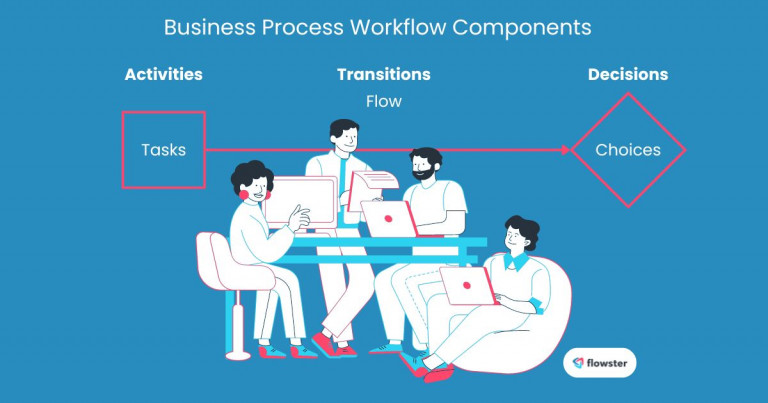In today’s fast-paced business landscape, small and medium-sized enterprises (SMEs) often struggle with inefficiency, lack of visibility, and delays in their operations. These challenges can hinder growth and limit profitability. A powerful solution lies in the implementation of business process workflows.
Business process workflows are the sequences of tasks and decisions that define how work gets done within an organization. By optimizing these workflows, businesses can streamline their operations, improve efficiency, and achieve greater scalability.
In this comprehensive guide, we will explore the concept of business process workflows, their significance in business growth, and practical steps to create and implement them effectively. We will delve into the key differences between workflows and processes, explore real-world examples, and discuss the benefits of workflow optimization.
Article Outline
What is a Business Workflow?
A business workflow is a series of interconnected tasks and decisions that collectively contribute to a specific business objective. It outlines the sequence in which activities are performed to achieve a desired outcome. Think of it as a roadmap that guides employees through the steps necessary to complete a particular process.
Examples of Common Business Workflows
- Order fulfillment: The process of receiving, processing, and fulfilling customer orders, involving steps like order entry, inventory verification, shipping, and invoicing.
- Customer onboarding: The sequence of actions taken to welcome new customers, including account creation, product setup, and training.
- HR recruitment: The process of finding, attracting, and hiring qualified candidates for open positions, involving steps like job posting, screening resumes, interviewing, and onboarding.
Benefits of Business Workflows
Business workflows are essential for efficient operations and growth. By clearly defining the steps involved in each process, businesses can:
- Improve productivity: Eliminate unnecessary steps and reduce bottlenecks, leading to faster turnaround times.
- Enhance quality: Ensure consistency and accuracy by standardizing procedures and providing clear guidelines.
- Increase visibility: Gain a better understanding of how work is performed, identify areas for improvement, and track progress.
- Support scalability: Adapt to changing business needs by easily modifying workflows to accommodate growth or new initiatives.
Moving forward, let’s explore the distinction between workflows and processes to gain a deeper understanding of their relationship.
Workflows vs. Processes: Understanding the Difference
While the terms “workflow” and “process” are often used interchangeably, there are distinct differences between them.
What are Workflows?
Workflows are subsets of processes, focusing specifically on the sequence of tasks and decision points within a broader process. They outline the steps that need to be followed and the order in which they should be executed. Think of workflows as the individual steps within a larger journey.
What are Processes?
Processes, on the other hand, encompass the entire set of activities required to achieve a particular outcome. They may involve multiple workflows and can be more complex and far-reaching. Processes define the overall framework, while workflows outline the specific steps within that framework.
To summarize, workflows are the detailed paths that guide employees through a process, while processes provide the broader context and objectives. By understanding this distinction, you can effectively design and manage your business workflows to optimize efficiency and achieve your goals.
Now that we have a clear understanding of the relationship between workflows and processes, let’s delve deeper into the concept of business process workflows.

Business Process Workflows: A Deeper Dive
Business process workflows are a structured representation of the sequence of activities, decisions, and transitions that define how work is performed within an organization. They serve as a visual map that guides employees through the steps necessary to achieve a specific business goal.
Components of a Business Workflow:
- Activities: The tasks or actions that need to be performed within the workflow.
- Decisions: Points in the workflow where a choice must be made, often based on specific criteria.
- Transitions: The connections between activities and decisions, indicating the flow of work.
Types of Workflows:
- Sequential workflows: The most basic type, where activities are performed in a linear sequence.
- Parallel workflows: Activities can be performed simultaneously.
- Conditional workflows: The flow of work depends on specific conditions or decisions.
- Iterative workflows: Activities may be repeated multiple times, often based on certain criteria.
- Event-driven workflows: Workflows triggered by specific events, such as customer requests or system alerts.
Challenges of Implementing Workflows:
- Resistance to change: Employees may be hesitant to adopt new processes or procedures.
- Lack of buy-in: Without support from key stakeholders, it can be difficult to implement and maintain workflows.
- Complexity: Complex workflows can be difficult to understand and manage.
- Data quality: Inaccurate or incomplete data can hinder the effectiveness of workflows.
- Technological limitations: Some businesses may lack the necessary tools or infrastructure to support workflow management.
By understanding the components, types, and challenges associated with business process workflows, organizations can develop effective strategies to streamline their operations, improve efficiency, and achieve their goals.
Flowster's AI-Driven Automation
Creating Effective Business Workflows: A Step-by-Step Guide
Creating a well-designed workflow requires a systematic approach and careful consideration of various factors. Here’s a step-by-step guide to help you create effective workflows:Step 1: Identify Stakeholders
Involve key stakeholders from all relevant departments to ensure buy-in and gather valuable insights.Step 2: Define Goals and Objectives
Clearly define the desired outcomes of the workflow, such as improving efficiency, reducing costs, or enhancing customer satisfaction.Step 3: Document the Current Process
Map out the existing process, identifying steps, decision points, and potential bottlenecks.Step 4: Analyze and Optimize
Identify areas for improvement, such as eliminating redundant steps, reducing wait times, or automating tasks. Create a new workflow that incorporates the optimized steps and decision points.Step 5: Model the Workflow
Use workflow modeling tools or diagrams to visualize the sequence of activities and transitions.Step 6: Test and Iterate
Pilot the new workflow to identify any issues or areas for improvement. Make necessary adjustments and iterate on the process until it meets your desired outcomes.Key Considerations: Creating Business Process Workflows
- Clarity and Simplicity: Ensure that the workflow is easy to understand and follow.
- Flexibility: Design the workflow to accommodate changes and adapt to future needs.
- Measurability: Establish metrics to track the performance of the workflow and identify areas for improvement.
- Scalability: Consider how the workflow can be scaled to accommodate growth or changes in business volume.
Tools and Technology: Managing Business Process Workflows
- Workflow management software: Tools like Flowster, ProcessMaker, and Nintex can help you create, manage, and automate workflows.
- Business process modeling tools: Software like Visio or Draw.io can be used to visualize and document workflows.
- Automation tools: Consider integrating automation technologies to streamline repetitive tasks and reduce manual effort. For SMEs undergoing this transition, engaging a fractional cto can help ensure the right systems are selected, implemented, and scaled effectively without the overhead of a full-time hire.
Capture Your Processes in Minutes!
Conclusion: Empower Your Business with Effective Workflows
In conclusion, business process workflows are a powerful tool for streamlining operations, improving efficiency, and driving growth. By understanding the components, types, and challenges associated with workflows, you can develop effective strategies to optimize your processes and achieve your business objectives.
Don’t wait to start optimizing your business processes. By implementing effective workflows, you can:
- Increase productivity: Streamline tasks and eliminate bottlenecks.
- Improve quality: Ensure consistency and accuracy in your operations.
- Reduce costs: Identify and eliminate inefficiencies.
- Enhance decision-making: Make data-driven decisions based on clear process information.
- Support scalability: Adapt to changing business needs and growth.
To get started, take advantage of our free business process workflow templates and other standard operating procedure (SOP) templates available at Flowster Marketplace. These templates can provide a solid foundation for creating your own workflows and streamlining your operations.
If you’re looking for expert guidance and support, Flowster also offers “Done-for-You” services. Our team of experienced professionals can help you analyze your existing processes, design optimized workflows, and implement them effectively.
By leveraging the power of business process workflows, you can unlock your business’s full potential and achieve sustainable growth.





